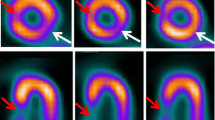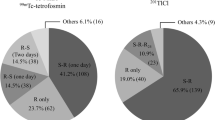Abstract
Background
Despite increasing emphasis on reducing radiation exposure from myocardial perfusion imaging (MPI), the use of radiation-sparing practices (RSP) at nuclear laboratories remains limited. Defining real-world impact of RSPs on effective radiation dose (E) can potentially further motivate their adoption.
Methods
MPI studies performed between 1/2010 and 12/2016 within a single health system were included. Mean E was compared between sites with ‘basic’ RSP (defined as elimination of thallium-based protocols and use of stress-only (SO) imaging on conventional single photon emission computed tomography (SPECT) cameras) and those with ‘advanced’ capabilities (sites that additionally used solid-state detector (SSD) SPECT cameras, advanced post-processing software (APPS) or positron emission tomography (PET) imaging), after matching patients by age, gender, and weight. Contributions of individual RSP to E reduction were determined using multiple linear regression after adjusting for factors affecting tracer dose.
Results
Among 55,930 MPI studies performed, the use of advanced RSP was associated with significantly lower mean E compared to basic RSP (7 ± 5.6 mSv and 16 ± 5.4 mSv, respectively; P < 0.001), with a greater likelihood of achieving E < 9 mSv (65.7% vs. 10.8%, respectively; OR 15.8 [95% CI 14 to 17.8]; P < 0.0001). Main driver of E reduction was SO-SSD SPECT (mean reduction = 11.5 mSv), followed by use of SO-SPECT + APPS (mean reduction = 10.1 mSv), ;ET (mean reduction = 9.7 mSv); and elimination of thallium protocols (mean reduction = 9.1 mSv); P < 0.0001 for all comparisons.
Conclusion
In a natural experiment with implementation of radiation-saving practices at a large health system, stress-only protocols used in conjunction with modern SPECT technologies, the use of PET and elimination of thallium-based protocols were associated with greatest reductions in radiation dose. Availability of several approaches to dose reduction within a health system can facilitate achievement of targeted radiation benchmarks in a greater number of performed studies.



Similar content being viewed by others
Abbreviations
- CAD:
-
Coronary artery disease
- E :
-
Effective dose
- MPI:
-
Myocardial perfusion imaging
- PET:
-
Positron emission tomography
- RSP:
-
Radiation-sparing practices
- SO:
-
Stress-only
- SPECT:
-
Single photon emission computed tomography
- SSD:
-
Solid-state detector
References
Chen J, Einstein AJ, Fazel R, Krumholz HM, Wang Y, Ross JS, Ting HH, Shah ND, Nasir K, Nallamothu BK. Cumulative exposure to ionizing radiation from diagnostic and therapeutic cardiac imaging procedures: a population-based analysis. J Am Coll Cardiol 2010;56:702-11.
Einstein AJ, Moser KW, Thompson RC, Cerqueira MD, Henzlova MJ. Radiation dose to patients from cardiac diagnostic imaging. Circulation 2007;116:1290-305.
Einstein AJ, Weiner SD, Bernheim A, Kulon M, Bokhari S, Johnson LL, Moses JW, Balter S. Multiple testing, cumulative radiation dose, and clinical indications in patients undergoing myocardial perfusion imaging. JAMA 2010;304:2137-44.
Cerqueira MD, Allman KC, Ficaro EP, Hansen CL, Nichols KJ, Thompson RC, Van Decker WA, Yakovlevitch M. Recommendations for reducing radiation exposure in myocardial perfusion imaging. J Nucl Cardiol 2010;17:709-18.
Henzlova MJ, Duvall WL, Einstein AJ, Travin MI, Verberne HJ. ASNC imaging guidelines for SPECT nuclear cardiology procedures: Stress, protocols, and tracers. J Nucl Cardiol 2016;23:606-39.
Einstein AJ, Berman DS, Min JK, Hendel RC, Gerber TC, Carr JJ, Cerqueira MD, Cullom SJ, DeKemp R, Dickert NW, Dorbala S, Fazel R, Garcia EV, Gibbons RJ, Halliburton SS, Hausleiter J, Heller GV, Jerome S, Lesser JR, Raff GL, Tilkemeier P, Williams KA, Shaw LJ. Patient-centered imaging: shared decision making for cardiac imaging procedures with exposure to ionizing radiation. J Am Coll Cardiol 2014;63:1480-9.
Dorbala S, Blankstein R, Skali H, Park MA, Fantony J, Mauceri C, Semer J, Moore SC, Di Carli MF. Approaches to reducing radiation dose from radionuclide myocardial perfusion imaging. J Nucl Med 2015;56:592-9.
Bateman TM, Heller GV, McGhie AI, Courter SA, Golub RA, Case JA, Cullom SJ. Multicenter investigation comparing a highly efficient half-time stress-only attenuation correction approach against standard rest-stress Tc-99 m SPECT imaging. J Nucl Cardiol 2009;16:726-35.
Gambhir SS, Berman DS, Ziffer J, Nagler M, Sandler M, Patton J, Hutton B, Sharir T, Haim SB, Haim SB. A novel high-sensitivity rapid-acquisition single-photon cardiac imaging camera. J Nucl Med 2009;50:635-43.
Lyon MC, Foster C, Ding X, Dorbala S, Spence D, Bhattacharya M, Vija AH, DiCarli MF, Moore SC. Dose reduction in half-time myocardial perfusion SPECT-CT with multifocal collimation. J Nucl Cardiol 2016;23:657-67.
Mercuri M, Pascual TN, Mahmarian JJ, Shaw LJ, Dondi M, Paez D, Einstein AJ, Group II. Estimating the reduction in the radiation burden from nuclear cardiology through use of stress-only imaging in the united states and worldwide. JAMA Intern Med 2016;176:269-73.
Tout D, Davidson G, Hurley C, Bartley M, Arumugam P, Bradley A. Comparison of occupational radiation exposure from myocardial perfusion imaging with Rb-82 PET and Tc-99 m SPECT. Nucl Med Commun 2014;35:1032-7.
Einstein AJ, Pascual TN, Mercuri M, Karthikeyan G, Vitola JV, Mahmarian JJ, Better N, Bouyoucef SE, Hee-Seung Bom H, Lele V, Magboo VP, Alexanderson E, Allam AH, Al-Mallah MH, Flotats A, Jerome S, Kaufmann PA, Luxenburg O, Shaw LJ, Underwood SR, Rehani MM, Kashyap R, Paez D, Dondi M, Group II. Current worldwide nuclear cardiology practices and radiation exposure: results from the 65 country IAEA Nuclear Cardiology Protocols Cross-Sectional Study (INCAPS). Eur Heart J 2015;36:1689-96.
Jerome SD, Tilkemeier PL, Farrell MB, Shaw LJ. Nationwide laboratory adherence to myocardial perfusion imaging radiation dose reduction practices: A report from the intersocietal accreditation commission data repository. JACC Cardiovasc Imaging 2015;8:1170-6.
Lindner O, Pascual TN, Mercuri M, Acampa W, Burchert W, Flotats A, Kaufmann PA, Kitsiou A, Knuuti J, Underwood SR, Vitola JV, Mahmarian JJ, Karthikeyan G, Better N, Rehani MM, Kashyap R, Dondi M, Paez D, Einstein AJ. Nuclear cardiology practice and associated radiation doses in Europe: results of the IAEA Nuclear Cardiology Protocols Study (INCAPS) for the 27 European countries. Eur J Nucl Med Mol Imaging 2016;43:718-28.
Otsuka R, Kubo N, Miyazaki Y, Kawahara M, Takaesu J, Fukuchi K. Current status of stress myocardial perfusion imaging pharmaceuticals and radiation exposure in Japan: Results from a nationwide survey. J Nucl Cardiol 2017;24:1850-5.
Mercuri M, Pascual TN, Mahmarian JJ, Shaw LJ, Rehani MM, Paez D, Einstein AJ, Group II. Comparison of radiation doses and best-practice use for myocardial perfusion imaging in US and non-US laboratories: Findings from the IAEA (International Atomic Energy Agency) Nuclear Cardiology Protocols Study. JAMA Intern Med 2016;176:266-9.
Thompson RC, O’Keefe JH, McGhie AI, Bybee KA, Thompson EC, Bateman TM. Reduction of SPECT MPI radiation dose using contemporary protocols and technology. JACC Cardiovasc Imaging 2018;11:282-3.
Songy B, Guernou M, Hivoux D, Attias D, Lussato D, Queneau M, Bonardel G, Bertaux M. Prognostic value of one millisievert exercise myocardial perfusion imaging in patients without known coronary artery disease. J Nucl Cardiol 2018;25:120-30.
Dorbala S, Di Carli MF, Delbeke D, Abbara S, DePuey EG, Dilsizian V, Forrester J, Janowitz W, Kaufmann PA, Mahmarian J, Moore SC, Stabin MG, Shreve P. SNMMI/ASNC/SCCT guideline for cardiac SPECT/CT and PET/CT 1.0. J Nucl Med 2013;54:1485-507.
Venero CV, Heller GV, Bateman TM, McGhie AI, Ahlberg AW, Katten D, Courter SA, Golub RJ, Case JA, Cullom SJ. A multicenter evaluation of a new post-processing method with depth-dependent collimator resolution applied to full-time and half-time acquisitions without and with simultaneously acquired attenuation correction. J Nucl Cardiol 2009;16:714-25.
Gowd BM, Heller GV, Parker MW. Stress-only SPECT myocardial perfusion imaging: a review. J Nucl Cardiol 2014;21:1200-12.
1990 Recommendations of the International Commission on Radiological Protection. Ann ICRP 1991;21:1-201.
Conversion coefficients for use in radiological protection against external radiation. Adopted by the ICRP and ICRU in September 1995. Ann ICRP 1996;26:1-205.
Case JA, deKemp RA, Slomka PJ, Smith MF, Heller GV, Cerqueira MD. Status of cardiovascular PET radiation exposure and strategies for reduction: An information statement from the cardiovascular PET Task Force. J Nucl Cardiol 2017;24:1427-39.
Depuey EG, Mahmarian JJ, Miller TD, Einstein AJ, Hansen CL, Holly TA, Miller EJ, Polk DM, Samuel Wann L. Patient-centered imaging. J Nucl Cardiol 2012;19:185-215.
https://www.fda.gov/radiation-emittingproducts/radiationemittingproductsandprocedures/medicalimaging/medicalx-rays/ucm115329.htm. US Food and Drug Administration. What are the radiation risks from CT?.
Disclosures
Drs. Patel and Al Badarin are supported by the National Heart, Lung, And Blood Institute of the National Institutes of Health under Award Number T32HL110837. The content is solely the responsibility of the authors and does not necessarily represent the official views of the National Institutes of Health. Dr. Spertus receives research grant support from Abbott Vascular, Novartis, and is the PI of an analytic center for the American College of Cardiology. He serves as a consultant to the United Healthcare, Bayer, Janssen, AstraZeneca, and Novartis. He has an equity interest in the Health Outcomes Sciences. Dr. Bateman receives research grant support from Astellas and GE Healthcare. He serves as a consultant to GE Healthcare. He has ownership interest in Cardiovascular Imaging Technologies. He has intellectual property rights for Imagen Pro/MD/Q/3D software. The other authors have no conflicts of interest to disclose.
Author information
Authors and Affiliations
Corresponding author
Additional information
Publisher's Note
Springer Nature remains neutral with regard to jurisdictional claims in published maps and institutional affiliations.
The authors of this article have provided a PowerPoint file, available for download at SpringerLink, which summarizes the contents of the paper and is free for re-use at meetings and presentations. Search for the article DOI on “SpringerLink.com.”
Electronic supplementary material
Below is the link to the electronic supplementary material.
Rights and permissions
About this article
Cite this article
Al Badarin, F.J., Spertus, J.A., Bateman, T.M. et al. Drivers of radiation dose reduction with myocardial perfusion imaging: A large health system experience. J. Nucl. Cardiol. 27, 785–794 (2020). https://doi.org/10.1007/s12350-018-01576-w
Received:
Accepted:
Published:
Issue Date:
DOI: https://doi.org/10.1007/s12350-018-01576-w




